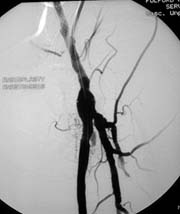The picture below is an angiogram of the blood vessels around the hip joint.
An angiogram is a special form of x-ray that permits the diagnosis of blockages (occlusions) or narrowings (stenosis) in the arteries of the body. During the test, a tube (catheter) is inserted into an artery at the groin. A special radio-opaque dye (contrast medium) is injected down the tube and x-ray pictures are taken as the solution passes along the blood vessels. The whole procedure usually lasts approximately one hour. The arteries take blood from the heart to supply oxygen to muscles and organs and the angiogram will tell your doctor if the supply of blood is abnormal. The procedure is performed by a specialist interventional radiologist or a vascular surgeon.

You will normally be admitted to the ward for a few hours beforehand to check out your general health and to prepare you for the angiogram. On the day of the test you may eat and drink as normal although this may vary between hospitals. If you take regular medications you should take your usual morning doses. The only exception to this might be if you are taking warfarin, in which case you should follow instructions provided for you. Frequently warfarin is stopped before an angiogram, but not always. If you have diabetes and inject insulin you should have your normal food and insulin dose, unless instructed not to. On arrival, you will be seen briefly by the doctor, the test will be explained to you and you will be asked to sign a consent form. This is to ensure you understand the test and its implications. Please tell the doctor if you have had any allergies or bad reactions to drugs or other tests. It would also be helpful to mention to the doctor if you have asthma, hayfever, diabetes, or any heart or kidney problems. Kidney problems can be particularly important. This is because the dye used to outline the arteries can damage the kidneys if special precautions are not taken. If you have any worries or queries at this stage don't be afraid to ask. The staff will want you to be as relaxed as possible for the test and will not mind answering your queries. You will be asked to put on a hospital gown. The test will take place in the x-ray department, a nurse will escort you and stay with you during the test. A small drip will be placed into a vein in the arm or hand during the procedure. This may be used to give intravenous fluids. It may be necessary to trim some of the hair from the groin area before the test to help skin cleaning.
Some injections may cause hot flushing for a few seconds, and an occasional feeling of wanting to pass urine. When the test is completed the catheter is removed and pressure will be applied to the groin for approximately ten minutes to minimise any bruising. Sometimes small devices can be deployed into the puncture site to seal the hole more quickly eg angioseal, perclose
You will be taken back to the ward to rest for a few hours. It is important that you lie quietly so that the groin does not bleed again. The nursing staff will check the groin, and foot pulses at regular intervals. If no pulses are present the colour and temperature of the foot is important. Providing all is well, you will be allowed home, but you need someone with transport to take you home, or to accompany you in a taxi. Some patients do require overnight stay. It is important that you rest completely until the next day to ensure that the puncture site in the groin heals up. If after you get home you notice any swelling or bleeding at the puncture site, you should press on this and call your GP's surgery for advice.
When do I know the angiogram result ?
The radiologist and vascular surgeon will look at the x-ray pictures and discuss their findings. They will decide the best form of treatment for you and then write to you, or see you again in the outpatient clinic. The treatment can then be discussed and as always it is the patient who decides whether to proceed with treatment or not. For most patients today angioplasty (see below) will be performed at the same time as angiography and so there will be no need to return for a further procedure.






No comments:
Post a Comment